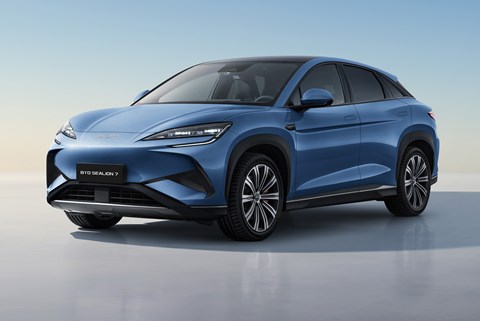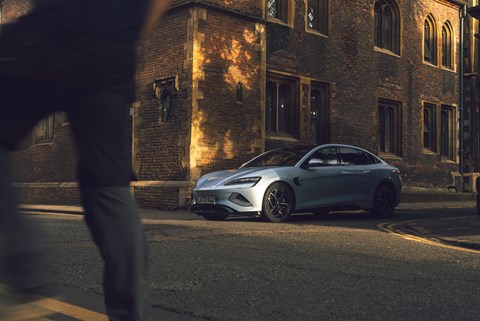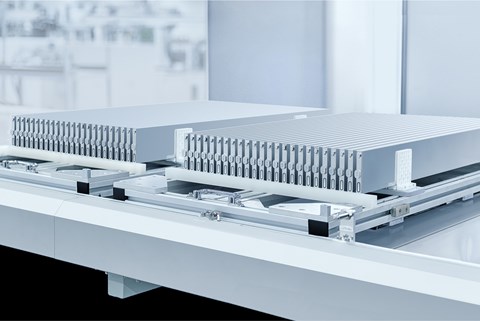► CAR sits down with BYD Europe head
► Li discusses BYD’s unconventional model names
► Plus, why the brand will weather industry storms
BYD, or Build Your Dreams, is on a roll in Europe. The brand is expanding fast, with new models like the plug-in hybrid Seal U DM-i and a wider range of variant options for the Dolphin in the UK and on the Continent coming on stream.
But the brand is also facing growing pains. It, along with other car brands based in China that are launching and expanding in Europe, are now becoming subject to tariffs in the region as the EU Commission intervenes with ‘anti-subsidy’ legislation.
Stella Li, BYD’s head of European operations, is right at the centre of the brand’s growth. We spend time with Li at the 2024 Paris motor show, not long before she and her team pull the covers off the new Sealion 7 (pictured below) – a battery-electric crossover that’ll go on sale in Europe to take on the Tesla Model Y.
BYD vs Manchester: our rock ‘n’ roll musical tour in a Dolphin

Li has gone on record that these additional tariffs on Chinese car makers are ‘unfair,’ telling Reuters that politicians should ‘stay away’ from them as it is only ‘adding more cost to auto manufacturing and confusing the industry.’
So, how will BYD weather the storms in Europe, as it and so many other Chinese car makers gain more of a foothold in the region despite these additional measures? ‘We’re the global number one for new energy cars. Our global market share for NEV is 23 per cent, which is an amazing number,’ Li tells us. For reference, ‘new energy’ vehicles include conventional hybrids, plug-in hybrid models and battery-electric cars, as well as hydrogen fuel cell models.
‘In the end, the industry will wash out the true competitors,’ Li adds. ‘You need a company that not only has the technology but the financial stability, manufacturing capacity and a real business plan for the future.’ As well as BYD’s enormous manufacturing capacity in its home country, the brand has plans to manufacture models in Europe, having already announced a new car manufacturing plant in Szeged, Hungary. A deal has also been made with the Turkish government for an additional manufacturing facility in the country.

Despite uphill political battles, Li says it is ‘so satisfying’ to see BYD models on the roads in Europe, adding that consumers in the region ‘are the best.’ But Li also acknowledges that BYD is still in the brand-building phase with European consumers; ‘they’re a little conservative, true, and they need time to understand you but that’s just a timing measure. Once they build that trust with us, we should be okay.’
A key differentiator for BYD is the brand’s rather unconventional names for its cars; Seal, Dolphin, Sea Lion and the like aren’t the usual sort of names given to cars – at least to typical European tastes. Surely that’s a shrewd marketing strategy? ‘Yeah, maybe when people talk about BYD, the name might not be sexy but at least they’re talking about us!’ smiles Li. ‘I’m joking, of course, but the more you enjoy the car itself, you almost ignore the name.

‘And with models like the Seal and new Sea Lion, we’re looking to people who are interested in nature – we’re saying that these cars are designed to be a part of nature and not damaging it. So that is where these names are good – it may be strange to the rest of the car industry, but it’s unique for us.’
While the lower end of the car market now looks a little shakier with new tariffs in place, BYD’s extreme, luxury Yangwang sub-brand has garnered interest. Its U9 supercar features advanced suspension that can keep the car level even if it’s driving on three wheels, while the monstrous U8 SUV can tank turn. Li also points to technical demonstrations of the U8 not just wading but swimming through deep pools of water without any negative effects.

‘It’s been a shock [for Europe], I think, but it’s the same reaction we’ve had from Chinese consumers,’ Li says of the Yangwang brand. ‘It’s given us a strong confidence, and people are believing what we say when we talk about a technology-defined future.’
Which is a particular BYD strong point. The company started life as a battery manufacturer, moving onto building consumer electronics before expanding into the automotive segment. The industry’s logical next step in battery tech, though is solid state; Toyota claims it will sell a car with a SSB in 2026, with Nissan claiming the same for 2028 for example. Where does BYD stand? ‘Every single technology [in a car]… BYD has a place to engineer it and to study it,’ says Li. ‘But going from the lab to being commercially available is a long way – you need a lot of verifications and test drives and even abuse to make sure it’s safe. And safety is the number one priority for BYD.

‘Secondly, you need to think about manufacturing capacity and cost competitiveness of the technology. At the moment with solid state, it’s still to far to be commercialised.’
Instead, the brand is more focused on its next generation LFP (lithium-ion phosphate) battery. Its ‘Blade’ battery tech is regularly touted by the brand as one of the safest on the market, and BYD is reportedly developing a new generation that is capable of 620 miles on a single charge under Chinese homologation tests.
Check out BYD Dolphin road trip to Manchester